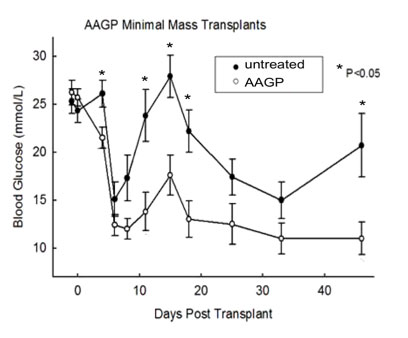Hussein and Pulambo, August 2007
Introduction
AAGP® has been shown to have positive affects on cell survival and functionality under conditions of serum withdrawal, freezing, low temperatures, inflammation and oxidative stress. Thus the aim of this investigation was to assess whether islet cells treated with AAGP® had improved functionality when transplanted into a diabetic mouse.
Method
Islet cells were treated with no or tri- AAGP® for 24 hours and then transplanted into Streptozocin-induced diabetic mice. The blood glucose levels of the mice (n =4 for AAGP® group and n=2 for control group) was measured over 40 days.
Results
Diabetic mice whose transplanted islet cells had been exposed to AAGP® for 24 hours post transplant (n= 3) had significantly (approximately 40%, at day 40) lower blood glucose levels than those diabetic mice whose transplanted islet cells had not been exposed to AAGP®. The AAGP® group also showed greater stability in blood glucose levels.

Conclusion
These results are very preliminary. However, they are a good indicator as to AAGPs® cell protective potential in vivo as well as in vitro.


